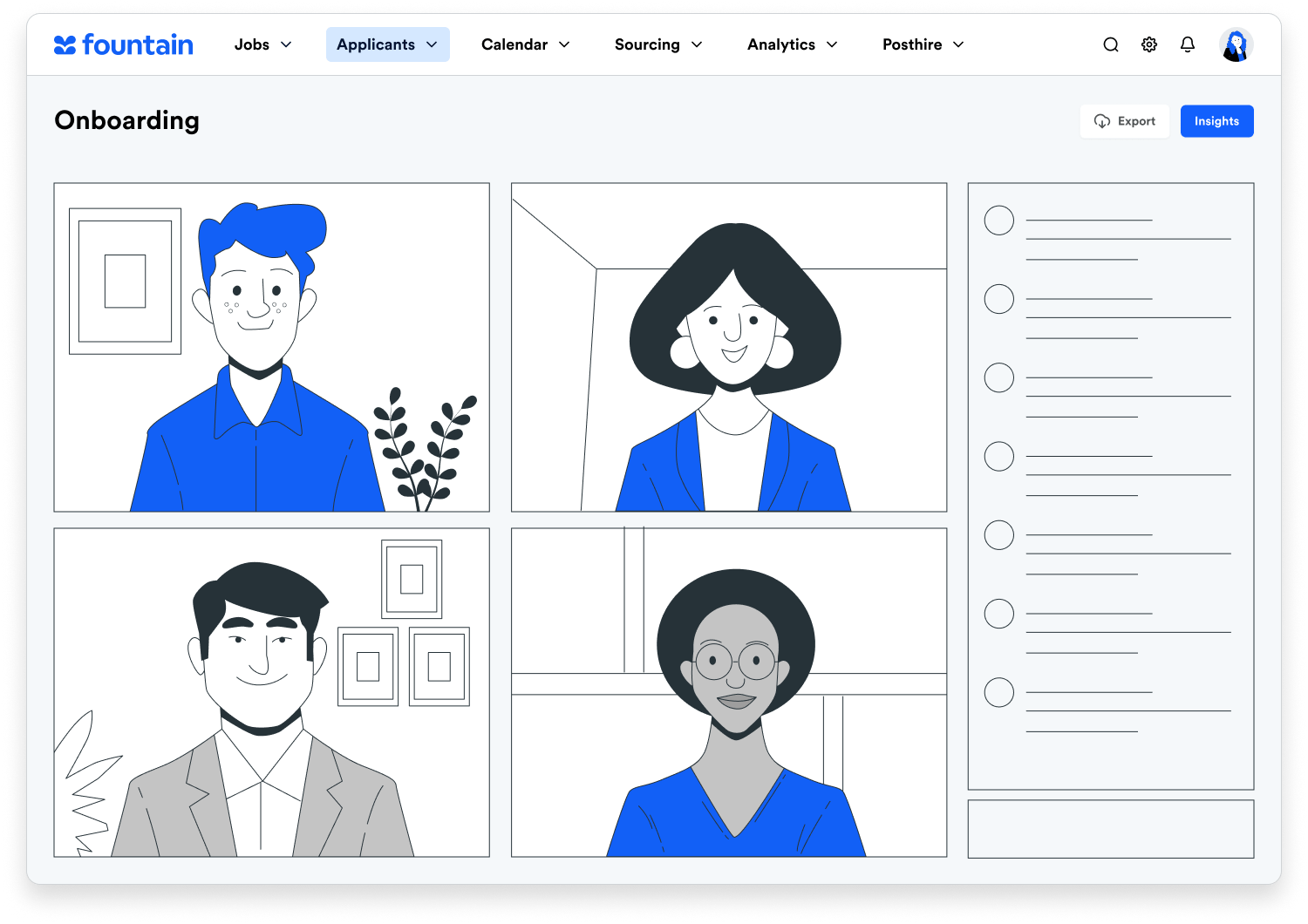Poor recruitment strategies can lead to hasty hiring decisions, low employee morale, and ultimately, a less productive workforce.
In this blog post, we will delve into the challenges of high volume recruitment and offer practical strategies to improve the process. Whether you’re a recruiter, HR professional, or business owner, this post will provide you with valuable insights and tools to streamline your recruitment efforts when using an applicant tracking system (ATS) to ensure successful outcomes.
What is high volume recruitment?
High volume recruiting is the process of filling a large number of hourly job openings within a short timeframe. This type of recruitment is often used by enterprise organizations across a variety of industries, including retail, hospitality, healthcare, and manufacturing. Oftentimes, high volume recruiting and hiring can fluctuate due to seasonal demands, rapid business growth, or expansion into new markets. In these cases, organizations need to quickly fill a large number of positions to meet their business needs.

Common challenges in the high volume recruitment process
Applicant volume
One of the biggest challenges in high volume recruitment and hiring is managing the sheer volume of applicants. With so many candidates to review, it can be overwhelming for recruiters to keep up with the pace of incoming applications. This can lead to delays in the hiring process and a risk of missing out on top talent.
To overcome this challenge, organizations can leverage technology such as a modern, made-for high volume applicant tracking system to streamline the recruitment process and manage the flow of applicants more efficiently.
Slow hiring speed
High volume recruitment requires a fast and efficient hiring process. If you don’t hire quickly, you risk losing top candidates to other organizations, and you won’t have the necessary staff to support your operations. To speed up the hiring process, organizations can:
- simplify their application processes,
- provide timely feedback to candidates, and
- use tools such as video interviews to speed up the selection process.
Overworked recruitment staff
With so many candidates to manage, recruiters can quickly become overworked and spread too thin. This can lead to burnout, mistakes, and candidate disengagement. To avoid this, organizations should invest in technology and AI tools that can automate manual processes and reduce the workload on recruitment staff.
Additionally, they can consider expanding their recruitment teams to ensure that recruiters have the resources they need to effectively manage high volumes of applicants.

Poor candidate experiences
A complicated application process or lack of communication about candidate status can lead to candidate disengagement and application abandonment. To improve the candidate experience, organizations should focus on making the application process as simple and user-friendly as possible. This can include:
- using online application forms,
- providing clear instructions,
- using technology to automate manual processes, and
- using automation too notify candidates of their application status.
Inability to scale
High volume recruitment process strategies require organizations to be able to scale their recruitment operations quickly and efficiently. However, without proper visibility into the candidate pipeline, it can be difficult to know where to allocate resources and prioritize efforts. To overcome this challenge, organizations can use tools such as ATS software to gain better visibility into their candidate pipeline and make informed decisions about where to focus their recruitment efforts.
Strategies for improving your high volume recruitment process
Leverage ATS features specifically made for hourly hiring
An ATS can play a critical role in managing a high volume recruitment process. By leveraging features specific to the role and location that you’re hiring for, you can streamline your recruitment process and improve efficiency.
For example, if you’re hiring for retail hourly positions in a rural area around the winter holidays, you can use an ATS that is specifically designed for this type of work, one that can target people near the location and can handle the seasonal volume. This can help you manage the large volume of applicants more effectively and make informed hiring decisions.

Make it easy for applicants to apply
To attract top, qualified talent, you need to make it easy for applicants to apply. This means using mobile-first technologies that allow candidates to apply from anywhere, at any time. By meeting applicants where they are, you can reduce application abandonment and ensure that you’re attracting the right candidates for your open roles.
Automate manual steps
The manual steps involved in high volume recruitment, such as data collection and interview scheduling, can be time-consuming and prone to errors. To improve efficiency and reduce the workload on recruitment staff, organizations should automate as many manual processes as possible. This can include using AI-powered technology or natural language processing (NLP) tools to collect and store candidate data, schedule interviews, and provide feedback to candidates. This will also eliminate bias and standardize processes so they’re consistent across the board.
Optimize job descriptions
To attract the right candidates, it’s important to optimize your job descriptions to match the specific requirements of the hourly role. This means including relevant keywords, highlighting the key responsibilities and requirements, and providing a clear picture of the job responsibilities and pay. By doing this, you can attract the right candidates and reduce the time and resources required to find the right fit for your open positions.
Prioritize the candidate experience
The candidate experience is critical to the success of high volume recruitment. Candidates want to know where they stand in the process, and they expect timely feedback and clear communication. To prioritize the candidate experience, organizations should provide regular updates, schedule interviews promptly, and offer feedback on their candidacy. And if that becomes too time-consuming, leverage AI communication tools to keep candidates informed.

Track metrics to improve processes
It’s important to track key metrics to measure the success of your high volume recruitment efforts. This includes metrics such as:
- time-to-hire
- cost-per-hire
- applicant source, and more.
By tracking these metrics, you can identify areas for improvement and make data-driven decisions to optimized your high volume recruitment process over time.
Metrics to monitor for continuous success
Time-to-hire: Time-to-hire measures the amount of time it takes to fill a position, from the date the job is posted to the date a candidate is hired. This metric can help HR staff determine the efficiency of the recruitment process and identify areas for improvement, such as reducing time-to-hire or increasing candidate satisfaction.
Cost-per-hire: Cost-per-hire is a key metric that measures the cost of filling a position, including recruitment, selection, and onboarding expenses. This metric can help HR staff determine the cost-effectiveness of the recruitment process and identify areas for improvement, such as reducing time-to-hire or increasing candidate satisfaction.
Applicant-to-hire ratio: The applicant-to-hire ratio is a key metric that measures the effectiveness of your recruitment process. It reflects the number of applicants who are ultimately hired compared to the total number of applicants. This metric can help HR staff determine the efficiency of the recruitment process and identify areas for improvement, such as reducing time-to-hire or increasing candidate satisfaction.
Candidates by source: Tracking the number of candidates by source can provide valuable insights into the effectiveness of different recruitment channels. This information can help HR staff understand which sources are providing the most qualified candidates and allocate resources accordingly. For example, if social media is generating a high number of applicants but few are being hired, HR staff may want to reevaluate their social media strategy or adjust their sourcing tactics.
Hires by source: Similar to tracking candidates by source, tracking hires by source provides insights into the effectiveness of different recruitment channels. This metric can help HR staff understand which sources are generating the most hires and allocate resources accordingly. For example, if employee referrals are generating a high number of hires, HR staff may want to prioritize this channel and encourage employees to participate in the referral program.

Conversion rates: Conversion rates are a key metric that measures the effectiveness of the recruitment process. This metric reflects the number of applicants who are hired compared to the number of applicants who complete the interview process. Tracking this metric can help HR staff determine the efficiency of the recruitment process and identify areas for improvement, such as increasing candidate satisfaction or reducing time-to-hire.
Applicant-to-interview ratio: The applicant-to-interview ratio measures the number of applicants who are invited to interview compared to the total number of applicants. This metric can help HR staff determine the efficiency of the recruitment process and identify areas for improvement, such as reducing time-to-hire or increasing candidate satisfaction.
Candidate satisfaction score: Measuring candidate satisfaction is critical to improving the recruitment process and attracting top talent. This metric reflects the level of satisfaction that candidates have with the recruitment process and can provide valuable insights into areas for improvement, such as reducing time-to-hire or simplifying the application process.
Candidate rejection reasons: Tracking candidate rejection reasons can provide valuable insights into the recruitment process and identify areas for improvement. For example, if a high number of candidates are being rejected because of a lack of experience, HR staff may want to adjust the job requirements or consider offering training programs to help candidates develop the necessary skills.
Building recruitment and hiring solutions for the future
Treating hiring hourly workers differently than corporate workers is essential for achieving better business results. Hourly workers play a crucial role in many industries and are critical to the success of a business. However, the recruitment and hiring process for hourly workers is often different than that of corporate workers and requires a different approach.
By leveraging technology, optimizing job descriptions, prioritizing the candidate experience, and tracking key metrics, HR staff can improve the efficiency and effectiveness of the recruitment process for hourly workers. By doing so, businesses can attract and retain top talent, improve operational efficiency, and ultimately drive better business results.
Fountain is a Labor ATS that is optimized for hiring high volumes of hourly workers andbacked by an automated workflow that is specific to role and location. See Fountain in action by requesting a demo.
Streamline your high volume recruitment process from start to finish with Fountain
Fountain is full workforce management platform that is optimized for handling high volumes of hourly workers and backed by an automated workflow that is specific to role and location. See Fountain in action by requesting a demo.

